
Lane Motor Museum, Nashville
The “Mini” of the Minis
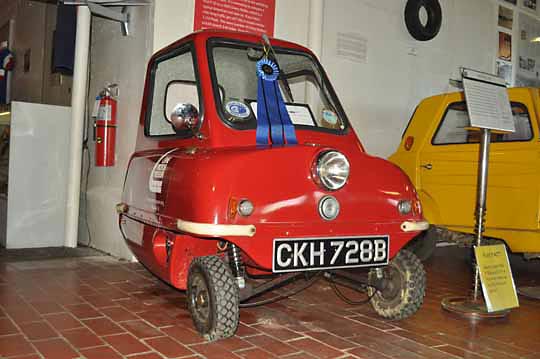
1965 Peel P-50
The Peel P-50 is the perfect car to start off a Microcar exhibit. It simply does not get any smaller than this, as the P-50 is recognized as the world's smallest production car. It's only fitting that the P-50 was made on a small island with small roads, the Isle of Man in the Irish Sea between the islands of Great Britain and Ireland. It was priced slightly above a scooter and had few comforts. The 50cc scooter engine is only slightly larger than most weed whacker engines which are 34cc. Since the engine was from a scooter there was no reverse. A handle was added to the back of the car and called a reversing handle. Also, instead of a kick-start to start the engine, a lever on the floor on the right side of the seat has to be pulled upward. The P-50 is actually quite roomy on the inside although getting in and out can be a little difficult for taller people. The fact that you could pack 43 of these cars in a modern 2-car garage is simply astonishing! It weighs a mire 220 pounds, has a top speed of 30 mph and carries a 1.2 gallon fuel tank.
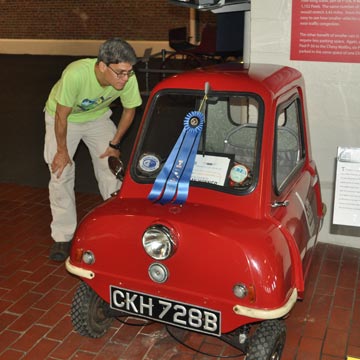
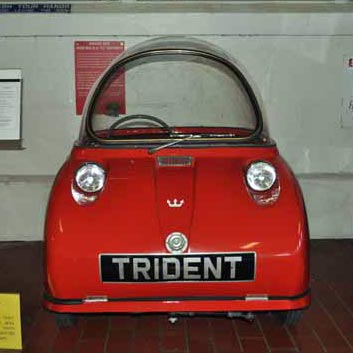
1965 Peel Trident
Peel Engineering holds a unique place in automotive history for producing the world's smallest car (P50) and the world's smallest 2-seater car — the Trident. The Peel Trident was an evolution of the P-50. It was made slightly larger to accommodate two modest-size adults. The Peel Trident is not very roomy and when two people sit in it, they are shoulder to shoulder. To save money, Peel Engineering used the same 50cc drive train in both the P-50 and the Trident. The bubble glass top which ratchets upward to allow entry works great from an ergonomic viewpoint — it works very poorly for ventilation, as on a sunny day, the car becomes an oven. With the Peel Trident weighing a minuscule 330 pounds, it is quite possible to double the weight of the car when two occupants climb inside. If so desired, you could place 31 of these little cars in your modern day 2-car garage.
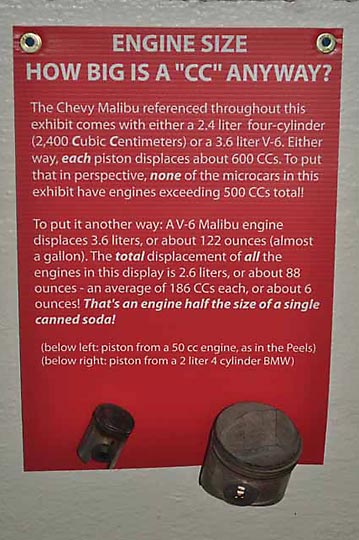
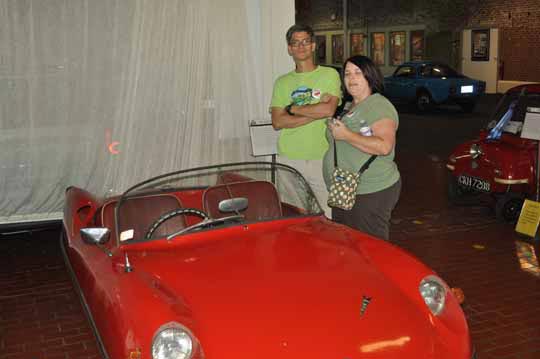
1960 Goggomobil Dart
An innovator by the name of Bill Buckle of Sydney, Australia, was the distributor of this German Goggomobil in the late 1950s. In an effort to get around the punishing import taxes imposed by Australia, he found it cheaper to import the chassis and then build his own fiberglass body. Buckle designed an open sports car — the Goggomobil Dart Roadster. Formed as upper and lower tubs, the body is a step-in without doors. A convertible top left a very small opening through which to enter, therefore a small door was offered on later models. The only instrument on the dash is a speedometer. The amount of fuel is gauged by a translucent gas tank. A rear-hinged hardtop and 400cc engine were later available. With the arrival of the Mini Cooper to the sports car market, Goggomobil sales dropped. The company produced a total of 5,000 cars over the span of business before closing in 1962.
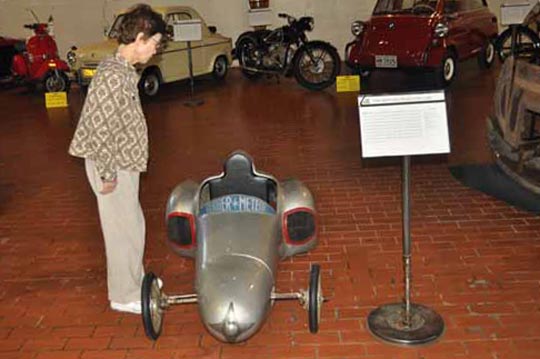
1948 Berger Reaction Car
This is a car? Hans Berger was a gifted engineer who built small helicopters and various mechanical devices. In 1948, he built the rocket-powered car shown here. Hans Berger also built the rocket engine that powered the car. His young daughter, Heidi, drove the car in local races. The first body constructed for the car covered all the wheels. The rocket engine had very little trust and a very short burn time. Because of that body proved to be too heavy and a lighter one was built without fenders. To start the car, a simple flip of a switch ignited the rocket. There was no throttle to control the thrust of the rockets. After a year of using the car, its power source was switched to a small motorcycle engine. Unfortunately, the small rocket motor that powered this car was lost. Top speed, amazingly, was only 35 mph but considering its miniature size, that might have been best.
Aerocars
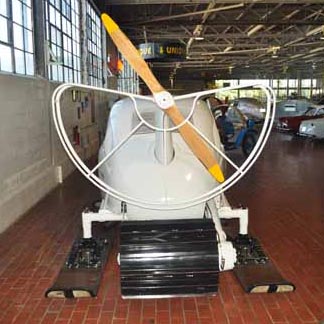
1942 Tatra Prototype Aeroluge
When Germany invaded Czechoslovakia in 1939, the German military dictated the output of Tatra factories. Shown here is an interesting project that was designed for war use only. The German military wanted Tatra to develop a vehicle that could move people across the vast snowy plains of Russia. Tatra began work on the Aeroluge in 1942. The few records that exist from that era seem to indicate that the Aeroluge was completed and went through some preliminary testing. It's quite possible that initial testing exposed many inadequacies and the war ended before further development could take place. Tatra built only one Aeroluge and it is in the Tatra Museum in Koprivnice, Czech Republic. This fully functional replica was built by Tatra specialist Ecorra in the Czech Republic over a five-year period and was completed in 2008.
How it works....The propeller was designed to move the vehicle once it gets up to a certain speed. The drum in the rear helps to get the vehicle moving and climb hills. The brakes are very interesting. When the brake pedal is pushed, the front skies skew inward to a snow plow position. Also, there are pins that push down through each rear ski and there is a small brake drum on the rear drive drum on the rear drive drum to assist in the braking. The drum has three speeds at which it will turn but the propeller is coupled directly to the engine.
How you drive it....Driving the Aeroluge is slightly complicated. First, lower the drive drum by cranking the small inside steering wheel in front of you. Then engage first gear and pull away. If you are on level ground, the drive drum can be cranked up to 10 mph and the propeller will push you. If the terrain is hilly,, the drive drum can be left down and the three speed can be used. Top speed is estimated to be about 48 mph. Stopping is quite simple, just push the brake pedal. When Ecorra initially undertook construction of the Aeroluge, the body was believed to be a modified T087. Further research proved this to be untrue although the doors and the engine are directly off a T-87 automobile.
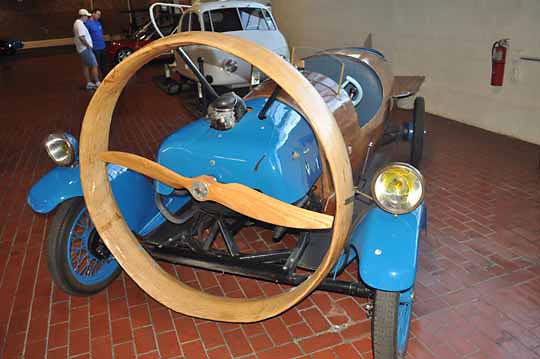
1932 Helicron
This one-of-a-kind propeller driven car was discovered in a barn in France in 2000. Having been placed there by the original owner in the late 1930s, little could be seen of it through the rubble. It was completely rebuilt but many of the mechanical components are original, such as the frame, wire wheels, dashboard, steering wheel, steering gear, brake pedal, light switch, headlights, and the type plate. The wood frame was sandblasted and treated, the steering gear was rebuilt and the interior was upholstered. The car steers with the rear wheels and only those wheels have springs.. It is equipped with a Citroën GS engine with the propeller coupled directly to the crankshaft. The Helicron passed the French safety inspection in 2000 and is approved for use on their roads.
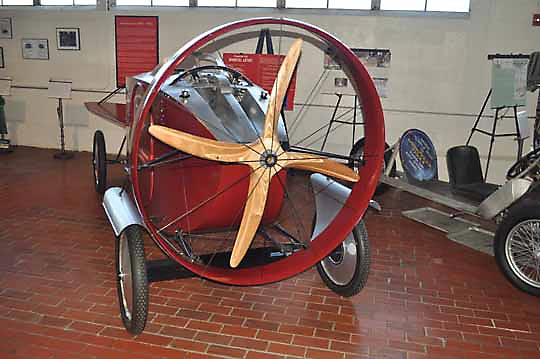
1919 Leyat Helico
Marcel Leyat was an engineer by degree who designed, built and flew his first airplane in 1909. Leyat developed the belief that propeller driven vehicles were the wave of the future. In 1913, he built his first propeller driven car. He tested this 1913 car extensively and in 1919 Leyat began production of this model. There were other people who also shared Leyat's belief about propeller power but it was Leyat who spent years trying to develop a viable propeller drive car. His theory was that the cars would be simpler. No transmission, rear axle or clutch and lighter in weight; therefore, they would be able to obtain better fuel economy. If you look at the Leyat closely, you can see how exquisite the engineering is. Leyat paid very close attention to aerodynamics and weight. The body, resembling an airplane, is fully streamlined — as is the front axle — to reduce drag. Instead of using traditional wheels, Leyat built his own with aluminum discs and integrated the brakes to further reduce drag. Weight was also reduced to a minimum by using a full monocoque chassis and many aluminum parts to obtain a total vehicle weight of 625 lbs. Leyat showed his car at the 1921 Paris Auto Show and claims to have received 600 inquiries. Unfortunately, Leyat was never able to get funding to go into large-scale production but he continued to build propeller driven cars until about 1926, with a total production of about 25 cars.
Back to the first page cars.
Let's go on to a second page for some really “mini-sized” cars.
Onward to page three for a really UGLY car & some very cool.
Onward to page four for more on Tatra of Czechoslovakia.